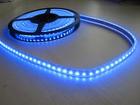White LED Driver drive power limited xenon lamp flash to illuminate the shooting scene provides a cost-effective choice. This article describes the basic concept of xenon lamp, and the details of a typical low-power based on the ON Semiconductor NCP5007 chip, low-cost flash drive circuit design.

Digital camera and is equipped with camera phones have new product into a mainstream product, these products within the digital image sensor based on CCD or CMOS technology. Able to support the image sensor in low light conditions, the flash circuit became necessary solutions for digital cameras, camera phones are becoming more common. Satisfy the flash requirements of the main light source is a xenon bulb and now the new high-brightness white LED lights.
The main advantage of the xenon lamp flash pulse generated by high power light output, while the advantages of the LED program is a relatively small size and thin, and longer conduction time in the video capture, the light output with the xenon lamp is only average compared. In particular, the xenon lamp flash pulse is very short, to enable the camera to capture photos made into a static picture. They need a special drive to produce high pressure and high energy storage capacitor to store electrical energy.
We found that the white LED panel driver to drive power limited xenon lamp flash to illuminate the shooting scene provides a cost-effective choice. This article describes the basic concepts of the xenon lamp, and details a typical low power / low-cost flash applications.
The xenon lamp has a glass enclosure at each end of an electrode, filled with low pressure rare gas mixtures. In the steady state, as shown in Figure 1, the voltage on the electrode is set lower than the trigger voltage. At this point, no current flows through, and the system remained stable until the trigger voltage applied to the third electrode. For the considered low-power light, this high-voltage pulse in the 1kV range, it comes with a small core transformer by a sudden discharge of the capacitor C2 is triggered.
The gas mixture is excited by plasma flash. For consumer applications, flash duration is 2ms. Flash type, the energy stored in the capacitor C1 can be as low as 1 joule (small camera), up to several thousand joules (professional application). Flash energy consumption shown in Equation 1:
Depending on the type of xenon lamp, the capacitor charging voltage is basically for 160V to 600V. The energy of low-power hand-held camera needs no more than a few joules, and the output voltage range of 160 to 250V. Higher voltages can be seen generally in a professional studio equipment used.
In addition to the DC voltage, high voltage pulse to excite the plasma in the bulb, high-intensity arc generated between both ends of the electrodes. Pulse amplitude depends on the type of lamp used in the system, ranging from lower 1.6kV to 10kV. Micro-xenon lamp is applied to the third external electrode of the lamp 1.6kV/5μs pulse triggers the pulse shown in Figure 2 for pulse transformer and high voltage capacitor connected arising. Charge the capacitor to the flash dc voltage (200V), and suddenly after the trigger button S1 to the pulse transformer primary side discharge. From the secondary side of high pressure is applied to the outer surface on the bulb, the flash is excited.
The main advantage of this concept is the light output and pulse duration is very short, quick photographs moving subject frozen at some point. The disadvantage of this design is the size of the storage capacitor, you need to board a higher voltage, and during filming capacitors need to be recharged (consumer applications, the charging time of 5-10 seconds).
According to the sensitivity of the imager and lens aperture in the general environment for consumer applications, a relatively small capacitance is sufficient to photograph in bright pictures. Therefore, you can use a simple converter to the battery voltage up to 200V voltage of the low-pressure xenon lamp required.
